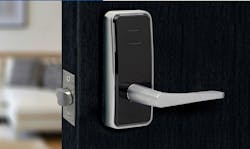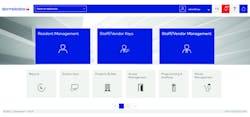Multifamily Housing Security Provides New Opportunities
Multifamily housing presents an important opportunity for forward-thinking security pros to grow their businesses. With market growth rates expected to continue for the foreseeable future, according to experts, security pros are crucial in helping to design and install access solutions — and to service them over time.
Locksmiths can best prepare to serve this market segment if they think past traditional one-off, or commodity, transactions, such as rekeying cores, and adopt a more holistic view of access solutions. In addition, they should acquire the necessary product or market knowledge to provide turnkey deployments and the support necessary to keep these systems operational and up to date. This includes working with suppliers to build extended relationships with multifamily-housing property owners and managers. (See “Breaking Into Multifamily.”)
Holistic Design
The definition of multifamily housing has expanded to include six subsegments: market-rate apartments, privatized student housing, senior living, military housing, subsidized housing and condominiums. These typically fall into either high-rise or sprawling-complex configurations. The basic security requirements of each are determined by the property’s design.
In a sprawling complex, such as privatized student housing, however, there could be 30 four-story buildings on a 40-acre campus. It’s more difficult to configure the property security in this scenario because of the many different access points that are part of the overall property and the degree of control that the developer or management group is looking to accomplish at each access point. There isn’t a one-footprint model for this type of multifamily housing.
So, multifamily security depends on understanding the basis of design (BOD) for the property from the customer’s point of view. It takes a holistic approach.
This represents a mind shift for locksmiths who have been trained to think more lock by lock. BOD documents the customer’s principles, assumptions, rationale, criteria and considerations that ultimately are used to build out the full property design. It identifies what’s most important for the building or complex and should line up with ownership or management operational guidelines. From there, security pros can think about locking solutions.
Applying BOD to security is relatively new but offers a huge opportunity for locksmiths to influence security design, regardless of whether the building is new construction or a remodel. When BOD is applied to security, locksmiths have to ask property owners and managers questions about specific security scenarios, such as:
- How far should nonresidents be allowed to get before they’re stopped by an access barrier?
- Does the building location dictate special security requirements?
- To what degree will campus security be monitored if part of an on-campus/off-campus environment?
The answers will help to define a playbook that can be used to outline the security solutions necessary for the property.
Old-style security thinking based access design around the idea of fortifying the exterior entrances first and foremost. It wasn’t necessarily dependent on electronic access. Modern access solutions require a more holistic approach that takes security to the next level. These should include electronic access control (EAC) products that keep residents safe while providing capabilities, such as using a phone as a credential, PIN-code capabilities at common amenity doors and the use of traditional credentials, all at the same time.
What might this look like? In a multifamily-housing property where food-delivery services might be in use, security pros and building designers might want a system that allows third parties to enter the building by using controlled PIN-code access up to a designated safe point where the service provider and resident then would meet.
Another type of common situation could be granting access for dog walkers, family visitors or visiting friends through the use of controlled Bluetooth mobile-key deployment. How residents, staff, guests and service providers move through each property is important in defining and streamlining the operational efficiencies for each property.
Make a Plan
The following steps are necessary to help with creating a security plan for multifamily housing.
Understand the BOD. Talk to the property owner or manager. Ask questions. Identify what’s important to them before making any recommendations. There’s no one-size-fits-all access solutions model, particularly in multifamily housing.
Choose the right solutions. Choose suppliers who provide true turnkey firmware, hardware and software, and make sure they provide training, including how the security pro can work with customers to make sure the system performs as expected. These providers should be consultative partners who work directly with you on each project from start to finish.
Invest in training. It’s easy to fall back on existing solutions, but multifamily housing, in particular, demands that security pros stay up to date on the latest advances. Manufacturers provide a variety of in-person and digital training programs. In addition, tech updates from manufacturers, trade media, trade events and trade memberships, such as in the National Apartment Association and others, can help you to become the best person to service your multifamily-housing customers today and tomorrow.
Bobby Welliver, CTS, SME, ESS, ISS, is the national sales manager for dormakaba’s multihousing access solutions group.
Breaking Into Multifamily
From the number of doors in a small area to the increasing demand for new smart locking solutions that allow for mobile credentials, there’s no question that the multifamily-housing market is a potentially lucrative one for locksmiths. But how does one get started in that market?
The first step, of course, is to familiarize yourself with the players and products. Manufacturers and distributors provide lots of training opportunities about electronic locks and access control.
Then what? Glenn Younger, president of Grah Lock & Safe in San Diego, says a good way to get started in multifamily is by providing service if not necessarily the products.
He notes that his company recently received business related to a massive apartment complex that’s under construction. All of the locks have been sold and will be installed by the builders; Grah just will make sure everything works. If a resident has a problem, “then we can trot out there, fix it, figure it out, replace the lock, do whatever.”
“Obviously, we could sell the system, and that’s a better deal for us,” Younger acknowledges. “Then we’re making money on the locks and on the service. But if the locks are already sold, [providing service is] an easy way to start.”
And how does one make themselves known to the large developers or manufacturers in the multifamily market? Being proactive and promoting yourself.
“You don’t even have to go sell the complex,” Younger says. Instead, you could go to the manufacturers. He suggests identifying the multifamily sales representative for a particular company in your area and calling them to introduce yourself and make a pitch.
“Just say, ‘I would like to do that.’” he says, meaning multifamily work. “‘I’d be happy to work on projects that you’ve already got in the pipeline that you’re selling. We could help you with installation.’ They’re looking for people like us.”
— Locksmith Ledger Staff
About the Author
Bobby Welliver
Bobby Welliver, CTS, SME, ESS, ISS, is the national sales manager for dormakaba’s multihousing access solutions group.


